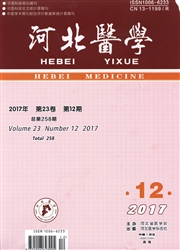

 中文摘要:
中文摘要:
目的:探究疾病谱对行心肺复苏术的急救患者的生存状况的影响。方法:随机选取2012年3月至2014年3月在我院急诊手术室因发生心脏骤停实施CPR复苏成功患者100例和复苏失败患者100例,分析两组患者的临床基本资料和直接病因。结果:复苏成功组大多为20-40岁患者(51例/100例,51%),复苏失败组患者年龄分布集中在60岁以上(45例/100例,45%),且差异具有统计学意义(P〈0.05);成功组和失败组在心肺复苏起始时间(100例/100例,100%;17例/100例,17%)、是否气管插管(91例/100例,91%;32例/100例,32%)和心电监护(79例/100例,79%;56例/100例,56%)均具有统计学意义(χ^2=12.829,P=0.000;χ^2=10.025,P=0.000;χ^2=4.982,P=0.000);直接病因主要为脑出血和梗死(44例/200例,22%)、冠心病(33例/200例,16.5%)、呼吸衰竭(40例/200例,20%)和急性心肌梗死(47例/200例,23.5%),且两组患者间原发性疾病差异均有统计学意义(P〈0.05)。结论:心肺复苏患者自主循环的恢复与患者年龄、原发性病、是否进行气管插管、心电监护和复苏起始时间有关。
 英文摘要:
英文摘要:
Objective: To expore the effect of disease spectrum on living condition of cardiopulmonary resuscitation survival of emergency patients. Method: A total of 200 emergency patients who accepted CPR with cardiac arrest( CA) in our hospital from Mar. 2012 to Mar. 2014 were randomized into success group( n= 100) and failure group( n = 100),basic clinical data and direct causes of CA were compared between the two groups. Result: Percentages in 20 - 40 ages( 51 / 100,51%) in success group were significant higher than failure group( P〈0.05) and percentage of more than 60 years( 45 / 100,45%) in failure group were significant higher than success group( P〈0.05) and significant increase in percentages of patients with starting time( 100 / 100,100%; 17 / 100,17%),tracheal intubation( 91 / 100,91%; 32 / 100,32%) and electrocardiograph( ECG)( 79 / 100,79%; 56 / 100,56%) in success group; patients with cerebral hemorrhage and infarction( 44 / 200,22%),coronary heart disease( 33 / 200,16.5%),respiratory failure( 40 / 200,20%) and acute myocardial infarction( AMI) were more likely to suffer CA than other patients and there's significant difference in two groups. Conclusion: Ages,primary diseases,tracheal intubation,starting time and ECG show the relationship with the rate of spontaneous circulation restoration.
 同期刊论文项目
同期刊论文项目
 同项目期刊论文
同项目期刊论文
 期刊信息
期刊信息
